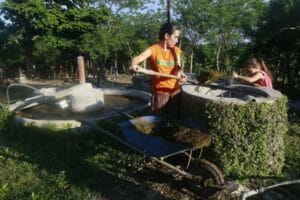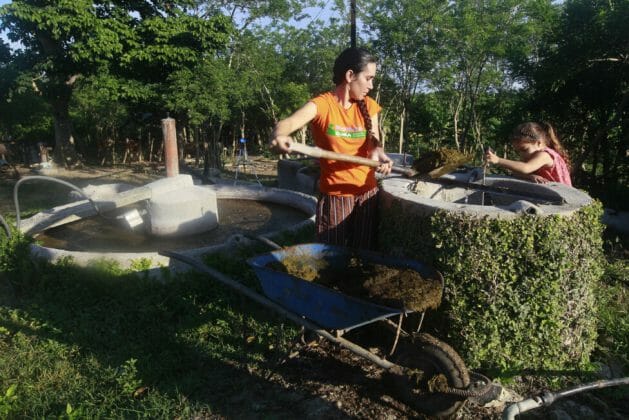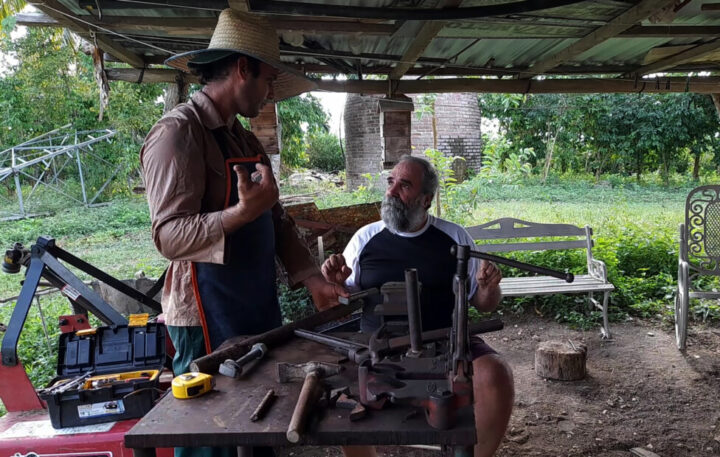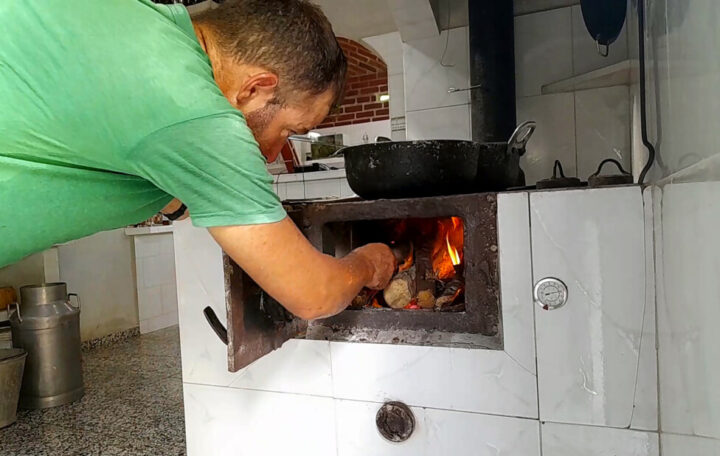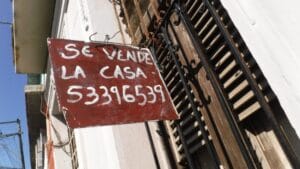
Civil Society, Development & Aid, Economy & Trade, Editors’ Choice, Featured, Headlines, Latin America & the Caribbean, Population, Poverty & SDGs, Regional Categories, TerraViva United Nations
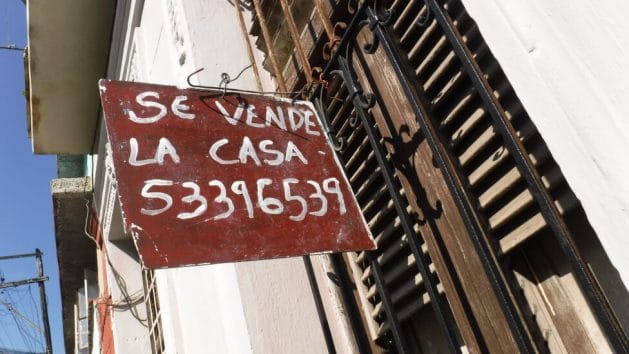
A “for sale” sign seen outside a house in Centro Habana. As you walk along the streets of the Cuban capital, you see a variety of “for sale” signs on a number of houses. The same is true in cities and towns in Cuba’s 168 municipalities. CREDIT: Jorge Luis Baños / IPS
– To emigrate to the United States and fulfill her hopes for a better life, Ana Iraida sold almost all of her belongings, including the apartment that, until her departure, saved her from the uncertainty of living in rented housing in Cuba, a country with an unresolved housing crisis.
“I inherited the apartment in Havana from my maternal grandmother, who passed away in 2015. It was small, but comfortable. I sold it for 6,000 dollars to pay for my documents, paperwork and airfare,” the philologist, who like the rest of the people interviewed preferred not to give her last name, told IPS.
“It is difficult to sell, because many people want to emigrate, and they are practically ‘giving away’ the houses. But at the same time hard currency is scarce and a person with thousands of dollars prefers to use them to leave the country.” — Elisa
From Houston, Texas in the U.S., where she now lives, the young woman said that, thanks to loans from friends, “I raised another 4,000 dollars. I got to Nicaragua in December 2022 and from there I continued by land to the U.S. border.”
Ana Iraida said she feels “fortunate” to have had a home that was “furnished and in good condition,” with which she covered her expenses. She said that others “have a more difficult time because they do not have a home of their own.”
In the last two years, emigration from Cuba has skyrocketed amidst the deterioration of the domestic economic situation, fueled by the COVID-19 pandemic, the tightening of the U.S. embargo, partial dollarization of the economy, the fall in the purchasing power of wages and pensions, shortages of essential products and inflation.
Errors and delays in the implementation of reforms to modernize the country and the ineffective monetary system implemented in January 2021 have also played a role.
In this country of 11 million people, in 2022 the exodus led some 250,000 people to the United States alone, the main receiving nation of migrants from this Caribbean island nation, from which it is separated by just 90 miles of sea.
To stem the wave of immigration, on Jan. 5 the U.S. government extended to nationals of Cuba, Nicaragua and Haiti a humanitarian temporary residency permit program, known as “parole”, similar to the one implemented in October 2022 for Venezuelans and previously for other nationalities.
As of the end of August, more than 47,000 Cubans had obtained the humanitarian permit, of whom 45,000 had already immigrated, according to U.S. Customs and Border Protection.
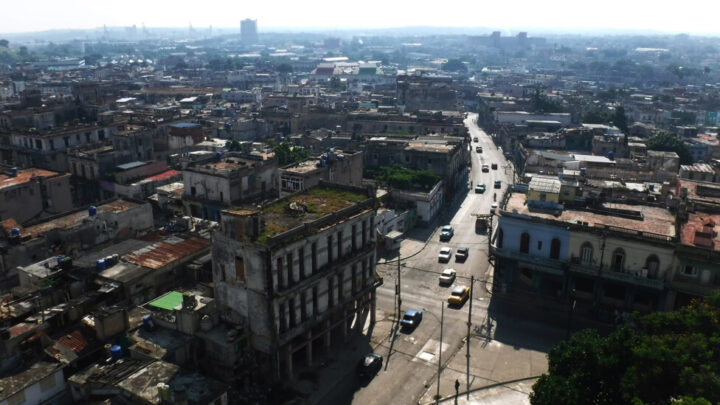
A view of Havana from Cerro, one of its 15 municipalities. This city of 2.2 million inhabitants, the biggest in the country, has the largest housing deficit in Cuba, exceeding 800,000 housing units. CREDIT: Jorge Luis Baños / IPS
One of the requirements for the temporary residency permit is to have sponsors who are U.S. citizens or hold some other legal status, in addition to having the financial resources to support the beneficiary or beneficiaries.
Swapping or selling parole
Owning your own home can also be an opportunity allowing whole families to move abroad.
“People are swapping houses for parole status. A few weeks ago I facilitated the exchange of a house for five parole permits to the United States. And in another case, with a residence in Miramar (a wealthy neighborhood in western Havana), nine people were the beneficiaries,” said Damian, a historian who privately engages in buying and selling, for which he charges a commission.
Damián explained to IPS that “residents in the United States ask for 10,000 to 12,000 dollars to provide a guarantee for parole status. The number of people they give a guarantee for depends on the value of the house. When the process is completed, the property is sold to a relative or friend of that person in Cuba.”
Walking through the streets in the Cuban capital, the most varied signs reading “for sale” can be seen on crumbling or remodeled buildings. The same is true in other cities and towns of the country’s 168 municipalities.
On online sites and Facebook groups for buying and selling activities, there is a proliferation of advertisements with photos and information about the properties, such as the number of rooms, the presence of a landline telephone line or an electrical installation that allows the connection of 110 and 220 volt equipment.
Some negotiate the price with or without furniture, others negotiate with buyers who pay cash in hand, or who pay in dollars, euros or make the deposit abroad.
“It is difficult to sell, because many people want to emigrate, and they are practically ‘giving away’ the houses. But at the same time hard currency is scarce and a person with thousands of dollars prefers to use them to leave the country,” said Elisa, a lawyer who told IPS she is interested in settling with her husband and son in Spain.
She said she has been trying to sell her apartment in La Vibora, another Havana neighborhood, for a year. “I can’t find a buyer, not even now that I dropped the price to 10,000 dollars, half the initial price, and it’s furnished,” she complained.
In Cuba’s informal real estate market, offers range from 2,000 dollars or less to a million dollars. The lowest of these figures is far from the average monthly salary, equivalent to 16.50 dollars on the black market.
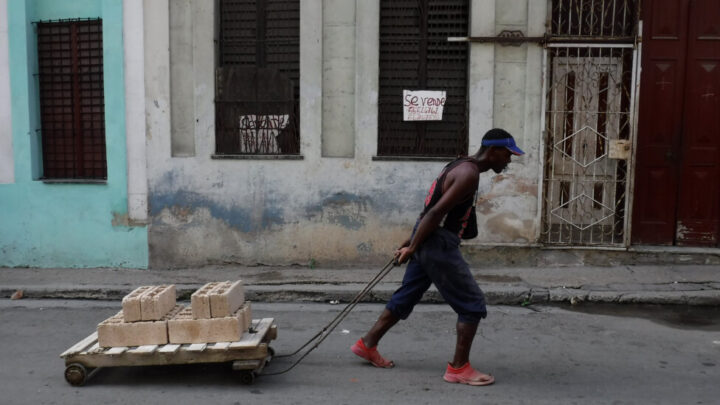
A man pulls a cart loaded with building blocks past a house for sale in the municipality of Centro Habana. In view of the government’s diminished construction capacity and the decline of funds for housing, since 2010 the government authorized the free sale of various materials for construction, repairs, remodeling and expansion. CREDIT: Jorge Luis Baños / IPS
Hurdles despite the reforms
Now, Cubans can sell their properties even to move away from the country, a situation very different from 15 years ago, when only swaps of houses between two or more owners were possible. Homes could only be sold to the government, and they were confiscated if the people living there emigrated.
Under laws passed in the early years after the 1959 revolution, most citizens became homeowners.
The Urban Reform Law of 1960 turned housing properties over to those who lived in them, prohibited their sale or lease, and abolished private construction and mortgages.
After decades of prohibitions, in October 2011 the 1988 General Housing Law was amended and the doors were opened to free purchase and sale between Cuban citizens and even foreign residents, endorsed before notaries and with the payment of taxes.
The law also eliminated certain formalities and official regulations on swaps.
Prior to the restitution of the right of ownership of residential units, in 2010 the government approved permits allowing people to build, repair or expand their own homes.
In view of the government’s reduced capacity for construction and the decline in housing funds in that same year, the free sale of cement, sand, gravel, cement blocks and corrugated iron bars was also authorized, which until then had been exclusively centrally allocated or sold in convertible pesos (CUC, a now defunct currency equivalent to the dollar).
The authorities promoted the granting of subsidies to vulnerable families, especially those affected by hurricanes, and micro-credits to build, expand or remodel homes.
These measures helped drive a boom in private construction and repairs.
As in other areas marked by the scarcity of materials, red tape and unequal purchasing power, the granting of housing and sale of materials is not exempt from corruption, theft and poor quality work, which has given rise to repeated complaints from the public.
There is still a housing deficit of more than 800,000 homes, while one third of Cuba’s 3.9 million homes are in fair or poor condition.
The largest deficits are concentrated in Havana, a city of 2.2 million inhabitants, as well as in Holguín, Santiago de Cuba and Camagüey, the other three most populated cities.
In 2019, a Housing Policy was launched, aimed at eliminating the housing shortage within a decade, based on the incentive of local production of construction materials and recyclable inputs, in addition to the contribution from the government and the centrally planned economy.
But the policy has run into hurdles as a result of the economic crisis, and multiple factors such as delays in paperwork and procedures, loss of material resources, unfinished subsidies and financial resources tied up in the banks.
The shortage of foreign currency and insufficient investment stand in the way of increasing production and incorporating equipment to boost construction capacity and sustainability.
Official data show that in 2022, more than 195 million dollars were dedicated to business services, real estate and rental activity, including hotel construction, which represented almost 33 percent of investment in the sector.
On the other hand, only 8.5 million dollars were allocated to housing construction, or 1.4 percent of the total, according to the government’s National Statistics and Information Office (ONEI).
Since 2019, 127,345 housing units were completed and 106,332 were remodeled or repaired, said Vivian Rodriguez, general director of Housing of the Ministry of Construction, during the most recent session of the Council of Ministers, on Oct. 1.
The authorities acknowledged that compliance with the year’s plan of 30,000 new units is under threat. Maintaining this pace would mean eliminating the housing deficit in more than 28 years.
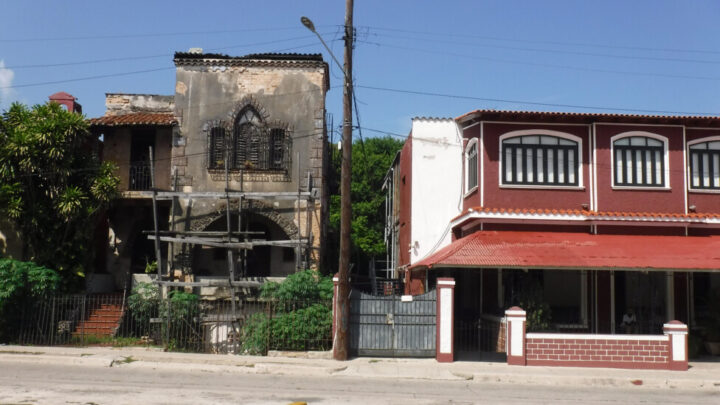
A rundown house stands next to a newly remodeled home on a street in the municipality of Playa, Havana. A third of Cuba’s 3.9 million homes are considered to be in fair and poor condition. CREDIT: Jorge Luis Baños / IPS
No immediate solution
The lack of housing and the deterioration of existing homes continue without a viable solution in the short or medium term.
On many occasions, people of different generations are forced to live together in small homes, many of which are in a state of disrepair, putting a significant number of families at risk.
Access to housing has also been identified as a factor in the low birth and fertility rates that Cuba has been experiencing for decades.
There is also a problem after tropical cyclones and heavy rains, when centuries-old buildings that have never been remodeled or repaired collapse, or those vulnerable to strong winds are left roofless.
The private practice of professions such as architecture is also not allowed, and although since September 2021 the government has authorized the incorporation of micro, small and medium-sized companies, some of which specialize in the construction and repair of real estate, they still encounter obstacles to their practice.
“There could be many solutions, but in my opinion an essential one is that building materials must be available and at affordable prices; or that houses can be sold to workers so they can pay for them on credit. Otherwise, families will continue to be overcrowded, roofs and walls will collapse on us, or we will grow old without a place of our own,” Orlando, a prep school teacher living in Havana, told IPS.

